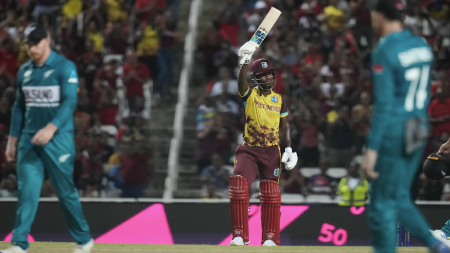Why isn’t Rohit Sharma hitting as many sixes as Marcus Stoinis, Aaron Jones? Muscle has outmuscled touch & timing this T20 World Cup
The doors of Barbados cricket slammed on Aaron Jones because, as the story goes, he batted too slow and didn’t fit the new-age white-ball hitter mould. Half a decade later, turning up for the USA, he helms the six-hitting charts of the World Cup, with 13 blows over the ropes, in three games. The fellow residents of the top-five six-hitters club are identical to him—none belong to the elite six-hitting league; all are distant from the T20 batting cream, all are mavericks with wildly fluctuating form. But one uniform and often devalued gift unites them all—the ability to generate muscle-bursting power into the shots, and clear the ropes.
On lethargic, sluggish surfaces of the West Indies and America, muscle has outmuscled touch. Batsmen resorting predominantly on timing rather than brawn—most batsmen rely on both components, only the degrees varies—have found that sixes, the money shot in the modern game, are not rolling off the bat as frequently as they used to. The programmable six-hitting machine of this era, Rohit Sharma has struck one in every 13.75 balls; Virat Kohli and Kane Williamson have yet to open the six-hitting registry; Mitchell Marsh (per 18.3 balls) and Babar Azam (per 29) have mustered just three apiece; Suryakumar Yadav only two in the 61 balls.

The pitch has been the villain in the piece. Too slow that batsmen can’t harness pace to hit behind square. Hence, fewer ramps, scoops and upper cuts. The pet six-fetching area has thus been the unfashionable cow corner. Too much of indifferent bounce, more so in the US, that hitting through the line is rolled in danger. Fewer, thus, the sixes over extra cover. That most splendid sight.
View this post on Instagram
A post shared by ICC (@icc)
Some of the recurring images of the tournament thus have been—balls getting stuck on the pitch, stopping on batsmen; batsmen mistiming, playing too early and too committed into the stroke, or toe-ending the delivery. And none of these, often, were not slower balls.
A string of low scores capture the story—200 has been breached just once in the first 26 games; in those there have been 34 instances of scores below 150. The average sixes per game has been 8.6. In comparison, an average of 17.81 maximums were wrought in the IPL. In such batting-unfriendly climes, power hitting has emerged the most valuable asset, and an understated art in itself.
It’s not a simple business, not a matter of blindly whacking the ball with all your might. It requires an awareness of your strengths, the field, an intuition about the bowler’s lengths, courage, self-belief, and of course immense power, be it from your shoulders, bat-swing, forearms or lower body. It’s fraught with risk, one could easily end up hitting the ball too hard, lose the balance and shape of the head and body. It’s tightrope, one that all these five have managed.
Different styles to maximise power
They generate power differently; Jones does so with his fluid transfer of weight and bat-swing. He often waits on the back-foot, clears the front-leg and clubs the ball over the midwicket fence. Eight of his ten sixes struck against Canada were parachuted through this region. Cow corner and long-on accounted for 12 of his 13 sixes. Only one was hit behind fine-leg, more a top edge off Mohammed Siraj. Rahmanullah Gurbaz has a broader hitting range; against New Zealand he flat-batted Trent Boult over his head for a thunderous six; against Uganda he hit a couple over long-off. But he, like Jones, has a leg-side predilection (five of his nine). But he is more of a front-foot player, likes to drill the ball down the ground, and uses his wrists and forearms to good effect.
The most naturally powerful among them is Marcus Stoinis, a devastating embodiment of explosive power. Often, he might not be in the best position to hit a six, but so powerful is he that he injects ample impetus into the stroke, from his shoulders and arms; West Indies’s Sherfane Rutherford channels a lot of power from the lower half of his body, which allied with his bat-speed, results in humungous sixes. Not the most muscled of men, but he gets a lot of body into his shots. When he pulls, he almost traces the full circle in the follow-through. Bangladesh’s Towhid Hridoy has an excellent oeuvre of strokes behind the square, but with little pace on the decks, he resorted to brute force for most of his six sixes. Apart from the glorious inside-out six he essayed on Wanindu Hasaranga, the rest were fashioned through the leg-side, often the deep midwicket region.
What makes them even more fascinating is that they are men of different builds—which debunks the big men hitting big sixes myth. Jones has a compact frame, stands at five foot eight inches, muscles don’t ripple from his forearms. Gurbaz is stockier, of broad shoulders and strong biceps: Marcus Stoinis is a bronze Greek God statue in flesh; Sherfane Rutherford is wiry and supple, like a middle-distance runner; Towhid Hridoy has the stringy physique of a racer. But all could whip up a dizzying force. It’s no coincidence that two of them—Gurbaz and Jones in that order, are the highest run-getters in the tournament too.
As the tournament progresses, with the pitches likely to get slower, their stocks could only shoot up. Others of their ilk would join them; the touch players could dial more power into their shots. But muscle has outmuscled touch this World Cup. It powered an unusual group of batsmen to the top of the six-hitting pile, too.
Get latest updates on T20 World Cup along with live score updates for all matches.
Disclaimer: The copyright of this article belongs to the original author. Reposting this article is solely for the purpose of information dissemination and does not constitute any investment advice. If there is any infringement, please contact us immediately. We will make corrections or deletions as necessary. Thank you.





